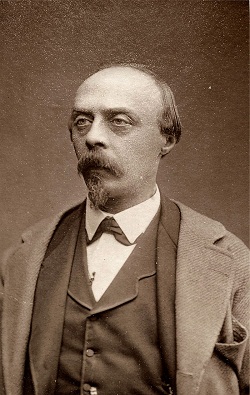How are you?
This week's lecture is “Johannes
Brahms”, the 15th topic of “Classical Music”, which is a summary of the contents of “100.
Classical Music: 15. Johannes Brahms” introduced on August
26th, 2017.
Johannes Brahms, born on May 7, 1833 and died on April 3, 1897, was a German composer, pianist and conductor of the Romantic era. Born into a Lutheran family in Hamburg, he spent most of his musical career in Vienna.
 |
| The building in Hamburg where Brahms was born (1891) |
He is sometimes included in one of the
"Three Bs" of music, first mentioned by 19th-century conductor Hans
von Bülow along with Johann Sebastian Bach and Ludwig van Beethoven.
 |
| Hans von Bülow |
Brahms composed works
for orchestra, chamber music, piano, organ, voice and chorus, and as a virtuoso
pianist, he premiered many of his own works. He worked with leading
contemporary performers, including the pianist Clara Schumann and the violinist
Joseph Joachim, and many of his works have become staples of the modern concert
repertoire.
 |
| Clara Schumann |
 |
| Joseph Joachim |
Brahms' father, Johann Jakob Brahms, was from the town of Heide in Holstein. Against the family's will, Johann Jakob pursued a musical career, and after arriving in Hamburg in 1826 he worked as a string and wind player and a professional musician. In 1830, he married a seamstress Johanna Henrika Christiane Nissen, who was 17 years older than he was.
 |
| Johannes Brahms (1853) |
Brahms received his first musical training from his
father and also learned to play the violin and the basics of playing the cello.
Having studied piano with Otto Friedrich Willibald Cossel from 1840, Brahms
made his debut as a performer at the age of 10. From 1845 to 1848 Brahms
studied piano with the pianist and composer Eduard Marxsen who was Cossel's
teacher, and in 1847 he made his first public appearance as a solo pianist in
Hamburg.
 |
| Eduard Marxsen |
In the summer of 1896, Brahms was diagnosed with jaundice, and later that year his doctor in Vienna diagnosed him with liver cancer. His last public appearance was on March 7, 1897, when he saw Hans Richter conduct his Symphony No. 4.
 |
| Hans Richter (conductor) |
His condition
gradually deteriorated, and he died on April 3, 1897 in Vienna at the age of
63. He was buried in the Vienna Central Cemetery under a monument designed by
Victor Horta along with sculpture by Ilse Twardowski-Conrat.
 |
| Brahms’ Grave in the Vienna Central Cemetery |
Brahms has been considered a traditionalist and an innovator by his contemporaries and later writers, and his music has its roots in the structures and compositional techniques of the Classical masters.
Although some of his contemporaries considered his music to be overly academic, his contributions and craftsmanship were praised by subsequent musicians such as Arnold Schoenberg and Edward Elgar.
 |
| Arnold Schoenberg |
 |
| Edward Elgar |
The highly structured character of Brahms' works was a starting point
and an inspiration for composers, and the romantic motifs are deeply embedded
within those structures.
 |
| Monument dedicated to Brahms, Max Klinger (1909) |
Thank you.





No comments:
Post a Comment